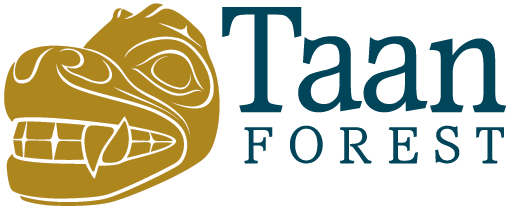
TAAN KAYDAAY
A Stewardship Division of Taan Forest
Taan Forest LP has embarked on an important journey by establishing our own stewardship division.
Taan Forest’s primary responsibility is to safeguard the precious natural environment of Haida Gwaii while practicing responsible and sustainable forestry.
-
Taan Kaydaay Bear Forest is the name given to our new stewardship division.
-
Taan Forest LP has embarked on an important journey by establishing our own stewardship division. Taan Forest’s primary responsibility is to safeguard the precious natural environment of Haida Gwaii while practicing responsible and sustainable forestry. We are dedicated to ensuring the long-term well-being of the forest, which provides us with a myriad of cultural, environmental, social, and economic benefits, not only for ourselves but also for future generations. Moreover, we are actively committed to rectifying historical damage caused by unsustainable logging practices, thereby advancing a more sustainable and harmonious relationship with our natural surroundings.
-
XXX
-
During World War II, our forests were extensively logged right up to, and in some cases, into the beautiful and biodiverse river and creek systems that crisscross Haida Gwaii and our tenure. In these areas, where clear-cutting left no trees or other natural features and were allowed to grow back unmanaged, we now face the challenge of dark and dense forests. The trees are too tightly packed to grow properly, resulting in spindly trees that cannot provide den or nesting habitat for species like taan black bears, ts’allang.nga marbled murrelets, or stads k’un northern goshawks. The crowded canopy also hinders the ability of Northern Goshawks to hunt, leading them to seek habitat elsewhere. The dark undergrowth prevents the growth of a diverse understory containing mushrooms, berries, ferns, and other valuable medicinal and cultural plants.
Our dedicated Haida Riparian Restoration spacers crew, combine their local knowledge with the expertise of supervisors to enter these areas and mark trees. Trees with the potential to grow large are identified and preserved, while other trees that would compete with them are either "girdled" (cut through the bark all the way around) or "topped" (have their tops cut off). This process restricts the flow of nutrients and water, slowly causing the marked tree to die.
Once a tree dies, it becomes a "snag" — a standing dead or dying tree. Snags are a vital part of forest ecology, comprising 10-20% of all trees in old-growth forests. The decaying wood provides a rich habitat for decomposers like bacteria, fungi, insects, and other invertebrates. This diverse ecosystem, along with the structural complexity of cavities, hollows, and broken tops, makes snags essential for birds, bats, and small mammals, which in turn support their predators; making them commonly referred to as ‘wildlife trees’ by foresters.
Our staff members may also "slash" or "scar" trees, simulating the natural process of trees falling and damaging surrounding trees as they come down. This method enhances the complexity of trees, creating features reminiscent of old-growth forests and restoring our forest's natural characteristics.
Working in these conditions can be incredibly challenging, and progress may seem slow and hard to discern. It's a highly skilled and creative job, where our team members need to act as ecologists, foresters, and architects, envisioning what the area will look like once the marked trees have been treated. At times, they may even need to girdle or scar a larger tree to better mimic and expedite the natural processes of our forests, ultimately creating an ecosystem with diverse tree sizes and ages.
In cases where tree stands are incredibly dense (X trees per hectare), we may need to implement a phased approach to our restoration efforts. Initially, we aim to reduce the tree density to approximately X trees per hectare before revisiting the area for further intervention.
Photos of before and after
To ensure the success of our restoration work, we are designing a comprehensive monitoring program that includes:
Bioacoustics: Monitoring changes in noise levels to detect an increase in bird song, serving as an indicator of improved habitat quality and biodiversity.
Camera Traps: Deploying camera traps to document an increased presence of wildlife species, such as black bears, Northern Goshawks, and other endangered species. Visual data will help us assess the positive impact of our restoration work on local fauna.
Anecdotal Evidence: Collaborating closely with local knowledge holders to gather valuable anecdotal insights and traditional ecological knowledge that provide additional context and guidance for our restoration efforts.
Carbon Monitoring: Measuring the size and growth of trees in the restored areas to track their ability to sequester carbon. This information is essential for understanding the environmental benefits of our restoration work and its contribution to mitigating climate change.
Meet the Team
-

Monet Goode
FOUNDER
-

Emmett Marsh
DESIGN DIRECTOR
-

Eleanor Parks
SUSTAINABILITY DIRECTOR















